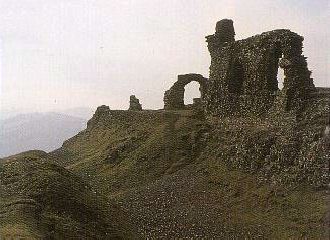 |
 |

Dinas Bran
[Wednesday - 05/05/99] Standing high above the north side of the Vale of Llangollen rises the high and remote hill of Dinas Bran, named after a king of Britain and the hero of the Mabinogion tale. He was killed following an invasion of Ireland, and his head was buried beneath the White Mount in London (now the site of the Tower of London). So long as the head remained buried, this Briton was safe against invasion; but King Arthur had the head exhumed, since he wished to protect the island through his strength alone. 'Bran' is the Welsh word for raven, and the story of his buried head is thought to be the motivation for the continuous, 900-year old presence of ravens at the Tower which people contend, to this day, keeps the country safe from invasion.
On the brow of the hill, stand the dramatic remains of a medieval castle. It is believed by the majority of Arthurian scholars to be the original model for the Grail Castle. This is interesting, since Bran, who was wounded in the thigh by a poisoned spear, may have been the origin of the mysterious Fisher King, the Grail's Guardian, who suffered a similar wound. Just as 'Bran' means 'raven' or 'crow' in Welsh, so does 'corbin', an old French word, and the name given to the Castle of the Grail by Malory in his 15th century Morte d'Arthur. The Fisher King of the Grail Castle was, in one version of the legend, called King Bron, and more than once, it has been suggested that Dinas Bran was the hiding place of the mystical Holy Grail. The thirteenth century Perlesvaus, or The High History of the Holy Grail, mentions Dinas Bran in terms which lead one to belief that Dinas Bran was indeed recognized as the Grail Castle.
The castle first appears in 12th century historical documents as part of a medieval piece entitled "Fouke le Fitz Waryn," or "The Romance of Fulk Fitzwarine." While this work claimed that the castle, known as "Chastiel Bran," was in ruin as early as 1073, the remains we see today date to the occupation of the princes of Powys Fadog in the mid-13th century. However, the encompassing ditch and earthen embankments, which enclose the southern and eastern portions of the stone fortress, belonged to a much earlier Iron Age fortress. They remind us that this hilltop had strategic value long before the princes of Powys, or the Normans, ventured into the region. Interestingly, the word, "Dinas," has its origins in the Iron Age as well, and is found in the names of Iron Age hill-forts throughout Wales.
Forced to climb to the summit some 1000 feet above the Llangollen valley floor, we experienced the struggle and the exhilaration that the castle's medieval inhabitants - and their attackers - must have felt! Without a doubt, the walk is a breathtaking challenge. However, that climb heightens the allure of Dinas Bran. And, it demonstrates the stark reality of medieval castle life. In the too-too-bizarre department, while on our way to Dinas Bran, we passed near a small town called Trefonen!
|
Last modified on Wednesday, November 26, 2008 URL: http://www.housecorvus.org/din.htm Copyright © 1999, 2000-09 House Corvus. All rights reserved. Design and hosting by Bran Trefonnen. | |